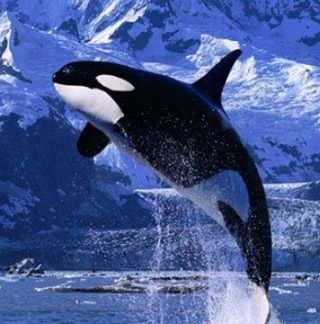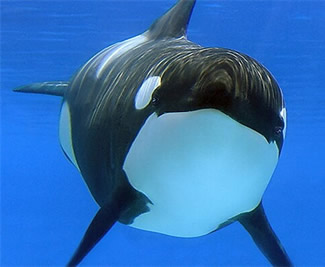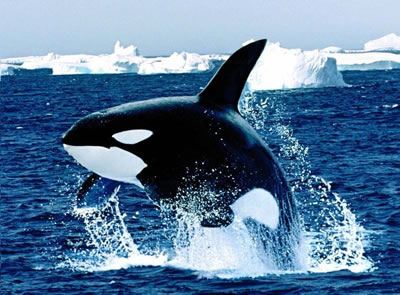Giant Whales

The biggest inhabitants of the oceans are whales. The whale popularly known as "the blue whale" weighs more than 150,000 kilograms (330,600 pounds) and is more than 30 metres (100 feet)long. To have a better grasp of the size of a whale, try to visualise a five-storey building: the blue whale is as long as a five-storey building is tall. Meanwhile, remember that this whale's weight equals the total weight of 25 to 30 elephants.
Well, how does such a giant animal manage to dive down to 800 to 1000 metres (around 2,625 feet)in depth and then resurface easily? For example, think of a ship of 150 tons (330,600 pounds) and thirty metres (100 feet) in length. If this ship sank to the bottom of the ocean – that is 1000 metres (3,280 feet) in depth – it would take a large-scale operation lasting years to re-float it. However, by the power that Allah has granted it, a whale can rise to the surface in 15 to 20 seconds. Because the bones of the whale are made of a spongy substance filled with oil, the whale can easily remain on the surface of the water.
The whale is also a very skilful diver. Allah has created a body for it that is very resistant to the great pressure in the depths of the ocean. The oxygen circulating in the blood and muscles combines with chemical substances that nourish it underwater or at times it does not breath. It has a circulatory system peculiar to it: it can send blood directly from the internal organs to the brain. This way, until the whale rises to the surface to breathe, it can send the oxygen in its body directly to the brain, the organ that needs oxygen most.
This magnificent system that amazes scientists is a manifestation of Allah's artistry. In this way, the whale can remain under the sea for more than 15 to 20 minutes without breathing.
Moreover, unlike human beings, whales aren't crippled by the bends when they rise very quickly to the surface.
You will probably ask what the bends are. The bends are a sickness that is caused after a rapid reduction in the surrounding pressure. When divers want to dive very deep underwater, they stop at certain points and make their body accustomed to that pressure in order not to be affected by alterations in pressure.

This way, they can reach very great depths slowly. But remember that they need to pause and rest at certain intervals during their return to the surface. Otherwise, due to pressure differences, the veins of the diver suffer harm resulting in his death. Whales do not have such a problem, because, Allah has given living beings the features they need to survive in their particular habitats. Whales can live in oceans whereas human beings can live on land.
You probably know that whales spray water from a hole on the top of their head. Do you know that this hole is actually a nose? The whale uses its nose only to breathe. Some people think that the whale only sprays water from this hole. The truth is, the whale releases the air in its lungs. Since this air contains water vapour and is hotter than the air outside, it is perceived as water from a distance.
The body of a whale is usually in the shape of a torpedo and is extremely suitable for swimming in water. While the tails of other fish are perpendicular to the water surface, the tails of whales are horizontal and parallel with the water surface. By means of this tail, the whale pushes itself ahead in the water.
There is a layer of fat approximately 50 centimetres (20 inches) under the skin of whales. The basic function of this layer is to maintain the body temperature at around 34 to 37 degrees Centigrade (93F to 98F).
At this point, it might be useful to remind you about the following: Contrary to the prevalent conviction, the whale and other fish do not drink seawater, because salty water is injurious to organisms. For this reason, they meet their need for water from the food they take in.
Each year in December and January, grey whales departing from the North Sea migrate to the southern coasts of Northern America and reach California. Their purpose in migrating to warmer water is to give birth. What is interesting is that the pregnant mother eats nothing throughout this journey; actually, she does not need to. Throughout the long summer days, she feeds in the rich waters of the North, thereby storing more than enough energy for a long journey. As soon as the female whale reaches the coast of west Mexico, she delivers her baby. Baby whales feed on their mothers' milk and store as much fat as possible. This preparation makes them strong enough for migration, which is due to start in March.

Like other mammals, the whale also nurses her babies. But, the babies cannot suck milk since they run the risk of swallowing seawater. As we mentioned before, salty seawater is injurious to whales. Interestingly, as with the dolphin, a muscle surrounds the milk glands of female whales. When the mother whale contracts this muscle, the resultant pressure enables the mother to spray the milk directly into her baby's mouth. This milk is dissimilar to the milk with which we are familiar. It is almost in a solid state and is quite fatty. Thanks to these features, the milk never mixes with the seawater. This substance the baby drinks–in fact, "eats"–dissolves in the stomach. This dissolved food also meets the water needs of the baby whale. As we have seen, Allah has provided baby whales with the most perfect nourishment.
The greasy, transparent secretion covering the eyes of the whale protects it from the harmful effects of the seawater. The whale has a keen sense of touch and hearing. It finds its direction in water by following the echoes of the sounds it makes. The working principle of this sense is similar to that of radar. In fact, this feature of whales has become the inspiration for the development of radar. Scientists believe that these sounds made by the whales constitute a very complex language. This language is important in the interaction and communication among them.
- Introduction
- The Squirrel: The Walnut-Lover
- Rabbits Like Carrots!
- The Loyal Animal: The Dog
- Little White Lambs
- Our Faithful Friends: Horses
- Horses In Stripes: Zebras
- Giraffes: Like Speckled Towers
- Giant Elephants
- Deer: Famous For Their Antlers
- Kangaroos and Their Pockets
- The Koala The Sleepyhead
- Playful Cats Who Want To Be Cherished
- The King of The Jungle: The Lion
- Wild Cats: Tigers
- Masked Pandas
- Bears are Fond of Honey
- Giant Snowmen: Polar Bears
- Fast Swimmers: Seals
- Penguins in Their Tuxedos
- Fisher Puffins
- Sovereigns of The Skies: Birds
- Long-Legged Storks
- A Pink Bird: The Flamingo
- Elegant Swans
- Ostriches (So Big That They can't Fly!)
- The Resplendent Peacock
- A Bird Which Mimics: The Parrot
- Ducks with Green Heads
- The Butterfly: A Miracle of Colours
- Inhabitants of The Oceans: Fish
- The Clown Fish
- Dolphins with Smiling Faces
- Giant Whales
- Conclusion
